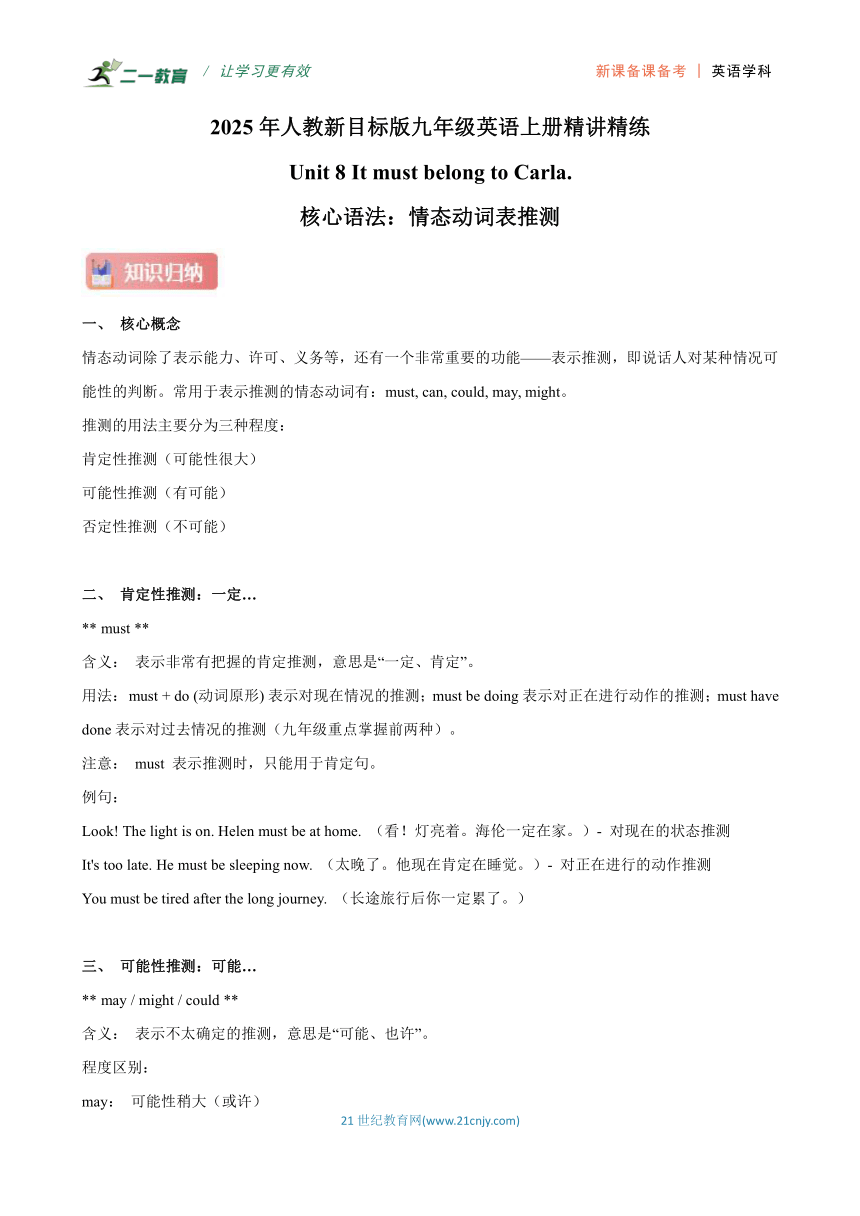
/ 让学习更有效 新课备课备考 | 英语学科 2025年人教新目标版九年级英语上册精讲精练 Unit 8 It must belong to Carla. 核心语法:情态动词表推测 一、 核心概念 情态动词除了表示能力、许可、义务等,还有一个非常重要的功能———表示推测,即说话人对某种情况可能性的判断。常用于表示推测的情态动词有:must, can, could, may, might。 推测的用法主要分为三种程度: 肯定性推测(可能性很大) 可能性推测(有可能) 否定性推测(不可能) 二、 肯定性推测:一定… ** must ** 含义: 表示非常有把握的肯定推测,意思是“一定、肯定”。 用法: must + do (动词原形) 表示对现在情况的推测;must be doing 表示对正在进行动作的推测;must have done 表示对过去情况的推测(九年级重点掌握前两种)。 注意: must 表示推测时,只能用于肯定句。 例句: Look! The light is on. Helen must be at home. (看!灯亮着。海伦一定在家。)- 对现在的状态推测 It's too late. He must be sleeping now. (太晚了。他现在肯定在睡觉。)- 对正在进行的动作推测 You must be tired after the long journey. (长途旅行后你一定累了。) 三、 可能性推测:可能… ** may / might / could ** 含义: 表示不太确定的推测,意思是“可能、也许”。 程度区别: may: 可能性稍大(或许) might / could: 可能性比 may 更小(说不定,也许) 用法: may/might/could + do (动词原形)。三者常可互换,但 might 和 could 语气更委婉。 例句: He may/might/could know the answer. (他可能知道答案。) It might rain later. Take an umbrella with you. (待会儿可能会下雨,带把伞吧。) She could be in the library. I'm not sure. (她可能在图书馆,我不确定。) 四、 否定性推测:不可能… ** can't / couldn't ** 含义: 表示有把握的否定推测,意思是“不可能”。 用法: can't/couldn't + do (动词原形)。couldn't 的语气比 can't 更委婉或更不确定一点,但常混用。 注意: must 表示推测时不能用于否定句。否定推测要用 can't 或 couldn't。 例句: That can't be Mr. Wang. He has gone to Shanghai. (那不可能是王老师,他去上海了。) She can't be only 15. She looks so mature. (她不可能只有15岁,她看起来太成熟了。) He couldn't have said that. He is a very kind person. (他不可能说过那种话,他是个很善良的人。)- 对过去的否定推测 五、 不同时态下的推测(进阶) 推测时间 句型结构 例句 中文 对现在/一般情况的推测 情态动词 + do (动词原形) He must be a teacher. 他肯定是个老师。 情态动词 + be + doing She might be having a class. 她可能正在上课。 对过去情况的推测 情态动词 + have + 过去分词(PP) The ground is wet. It must have rained last night. 地是湿的。昨晚肯定下雨了。 He can't have finished the work. 他不可能已经完成了工作。 注意事项(九年级重点): must 和 can't 是“反义词”: must (肯定) ←→ can't (否定) (√)He must be at home. (他肯定在家。) (√)He can't be at home. (他不可能在家。) (×)He mustn't be at home. (mustn't 不表示推测,它表示“禁止、不准”) 回答带表推测情态动词的问句时: —Can it be true (这可能是真的吗?) —Yes, it can. / No, it can't. (是的,可能。/ 不,不可能。)- 用 can/can't 回答 —Could he be our new teacher (他可能是我们的新老师吗?) —Yes, he could/might. / No, he can't. (是的,有可能。/ 不,不可能。) 可能性程度排序: must (100%) > may (50%) > might/could (30%) > can't (0%) ... ...
~~ 您好,已阅读到文档的结尾了 ~~